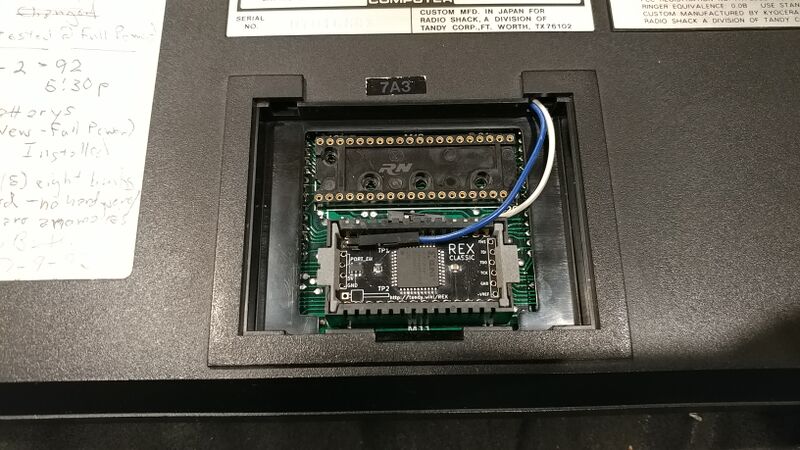Building a REX
Introduction
Building a REX
This is a version of Steven Adolph's REX Classic with a modified PCB design.
It is electrically identical to REX Classic, and uses the REX Classic firmware & software.
The PCB layout and shape are modified to:
- snap into a 3d-printed carrier to fit the Molex78805 socket
- provide connections for power and PORT_EN for programming the CPLD
Original version of this page, for building the original REX1
Parts & Materials
Other Compatible Flash Chips and how to identify them
Tools
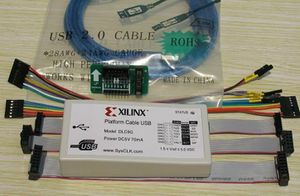
- Cheap Chinese clone is fine.
- Look at the pictures for ones that say model DLC9G, or DLC9LP. Don't put "DLC9G" or "DLC9LP" in the search, you will only get the overpriced ones.
- Get one that includes a "flying leads" cable, with separate loose individual wires on one end.
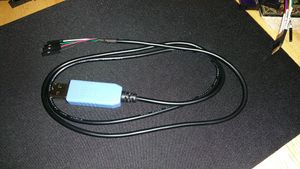
- A cheap usb-ttl cable is perfect. It's cheap, and already ends in loose wires with female dupont pins.
- Just use the red and black wires and ignore the rest.
- PC with at least one usb port, and a COM port or usb-serial adapter.
- Sandpaper, medium grit (120 or so), and a hard flat surface like a cutting board.
- Do not necessarily need anything fancy. I actually used this exact one to build a few REXs, although now I use a Hakko FX-888D.
- Or the strongest reading glasses you can get at a local drug store. 3.00x or higher.
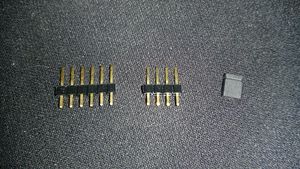
- 0.1" (2.54mm) pitch single row male pin header
- 1x6
- 1x4
- one shunt
- A Tandy Model 100, 102, or 200.
- Optional but recommended: Ultrasonic Cleaner and saponifying PCB cleaning solution and distilled or deionized water.
Software
- Xilinx ISE 14.7 Lab Tools
- Lab Tools is a subset of ISE. You can use either ISE or Lab Tools, but you only need Lab Tools to program the REX.
- This software is old and needs special futzing to make it work, no matter what OS you are using.
- Installing on Ubuntu Linux
- Installing on Windows.
- A TPDD_client to run on the M100
- There are several tpdd clients, and several ways to get one installed. These are a few options:
- For Mac, Linux, FreeBSD, any other unix: Get dlplus and use the bootstrap option to install TEENY.100 or any of the other options listed by "$ dl -l"
- For Windows: Get tsend.ps1 and use it to install TEENY.100 or any of the clients found at https://github.com/bkw777/dlplus/tree/master/clients
- Play File:DOS100.CO.MP3 into the cassette port to install TS-DOS. (SOUND OFF:CLEAR 0,57089:RUNM "CAS:DOS100.CO")
- Get a real tpdd and bootstrap it's utility disk to install "Floppy".
- A TPDD_server to run on a modern host machine
- For Mac, Linux, FreeBSD, any unix: dlplus
- For Windows: LaddieAlpha
- Start there, and follow the links to whatever is the latest "REX Release x.x Rebuild Package" zip file.
Procedure
Prep the Bare PCB
Lay a piece of medium grit (100-200) sandpaper face up on a hard flat surface like a cutting board.
Sand the edges of the PCB on the sandpaper just enough to clean off the panelization break-away points.
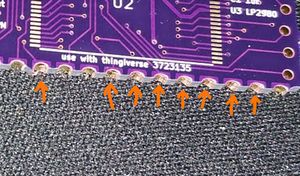
Use magnification to look closely at the castellated edge contacts for copper or gold "flags" hanging on the edge of most contacts. Scrape them off with an xacto knife.
Solder the Electronic Components
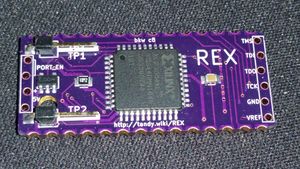
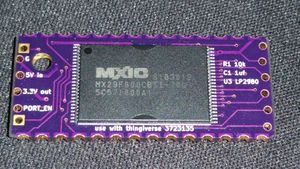
Solder these parts onto the matching labeled locations on the pcb.
- U1 = XCR3064XL
- U2 = 29F800
- U3 = LP2980-3.3
- R1 = 10K
- C1 = 1uF
- TP1 & TP2 = right-angle pin (optional)
Don't be too intimidated by the tiny legs on that TSOP-48 chip.
Just use magnifying glasses, lots of flux, and the DRAG TECHNIQUE.
Another example: https://youtu.be/09qb0KY_IF4
The TP1 and TP2 pins are only needed if you think you will ever perform the hardware modification required to use the main rom management feature. See FlexROM_100 or FlexROM_102 to facilitate this.
Clean the Finished PCB
Even "No-Clean" flux should still be removed as much as possible after soldering.
The best is to use an ultrasonic cleaner and saponifying pcb cleaning solution.
If you don't have that, then at least make sure your flux and solder are both "no-clean", and then use 99% isopropyl alcohol and a brush. This will still leave flux trapped under the chips no matter how much you soak it or wash it, but for no-clean flux it's not ideal but ok.
Program the CPLD
Now we need to flash the CPLD (Xilinx) with the .jed file. This configures the blank CPLD into a functional circuit that actually does something.
- Get the .jed file from here.
- Connect the jtag, 5vdc, and PORT_EN jumper.
Snap the PCB Into the Carrier
Place the end of the PCB without the hole into the carrier first, then snap the rest of it in.
Flash the Firmware
Follow the REX 4.9 update directions to load the firmware onto the REX.
The original directions for that are here: 4.9 update directions.
Here are explicit/literal example directions to do that using dlplus on a Mac, Linux, FreeBSD, or other unix pc.
(For Windows, instead of dlplus, use tsend.ps1 for the bootstrap in place of "dlplus -vb ...", LaddieAlpha for the TPDD server in place of "dlplus -vu" , and download the files manually with a browser instead of cutting & pasting the wget commands.)
Back up any files off of M100. M100 will be wiped.
Cold reset the M100 (ctrl+pause+reset)
Power off the M100
Install the REX in the M100's Option ROM socket
Connect the serial cable between M100 and PC
Power on the M100
Install dlplus on a PC:
On the PC, in a terminal window.
$ git clone git@github.com:bkw777/dlplus.git $ cd dlplus $ make all && sudo make install
Install TEENY onto the M100:
On the PC:
$ dl -vb TEENY.100
Follow the prompts on the PC and on the M100 screen...
On the M100:
- BASIC
RUN "COM:98N1ENN"
On the PC:
- Enter
- wait...
On the M100:
- Enter
NEW ?HIMEM:CALL9643
- Look at the
Top: #####number. - A 32k machine should say 62213.
- Yours may say something else.
- Use that number in the following CLEAR command.
CLEAR 0,62213 MENU
On the PC:
- Enter
- should be back at a shell prompt now
Download the REX Classic setup files
$ mkdir rex_setup $ cd rex_setup $ wget http://bitchin100.com/wiki/images/4/4f/R49_M100T102_254_rebuild.zip $ wget http://bitchin100.com/wiki/images/6/63/M100_OPTION_ROMS.zip $ unzip R49_M100T102_254_rebuild.zip $ unzip M100_OPTION_ROMS.zip
Use dlplus to start a TPDD server
$ dl -vu
Copy RF149.CO to the M100, then run it.
On the M100:
- should be at menu
- TEENY.CO
> L RF149.CO > Q
- should be at menu
- BASIC
CLEAR 0,55000 MENU
- should be at menu
- run RF149.CO
- Answer Y
- Wait...
- should be at menu
Reset the M100 to clear out TEENY and RF149.CO
- ctrl+pause+reset
- should be at menu, ram wiped
The flash memory on the REX is now formatted and loaded with REXMGR and a TS-DOS option rom image.
Install REXMGR from the REX itself
- BASIC
CALL 63012
- should be at menu, REXMGR should appear in menu
REX is now ready to use, and empty except for TS-DOS.
Now install an option ROM image. Example: Ultimate Rom II
- REXMGR
- press TAB once
- screen should say "TS-DOS* ------"
- press right-arrow once, highlight should move to "------"
- press F2
Loading from image filename: UR2100 Hit any key when TPDD ready. Loading 0:UR2100.BX ####
- now it should say "TS-DOS* UR2100 ------"
UR2 is now loaded into REX, but not currently selected/active, TS-DOS is.
What this means is, If you were to go back to BASIC and run CALL 63012 right now, it would load TS-DOS, as if you had a TS-DOS option rom in the option rom socket.
To run UR2, you have to select it in REXMGR first.
- right-arrow to highlight UR2100
- press enter
- Y
UR2 is now the active option rom image. Additionally, the equivalent of CALL 63012 was already done for you by REXMGR just as a convenience to skip a step.
F8 back to menu.
Leave dlplus running on PC while you load more rom images.
Ctrl+C to exit dlplus when you're done with it.
Done!
That was the last step. You're done! Consult the REX docs to start using it!
Main ROM Management
- For 100, see FlexROM_100
- For 102, see FlexROM_102
- For 200, no FlexROM for 200 yet. See the regular REX docs.
References
KiCAD source files for the PCB
OpenSCAD source files for the carrier
Version c6 pcb This version of the pcb is obsolete, but has pics of the firmware flashing process.
Version c8 pcb This version is also now obsolete, but the only difference is the pcb dimensions and matching carrier.
